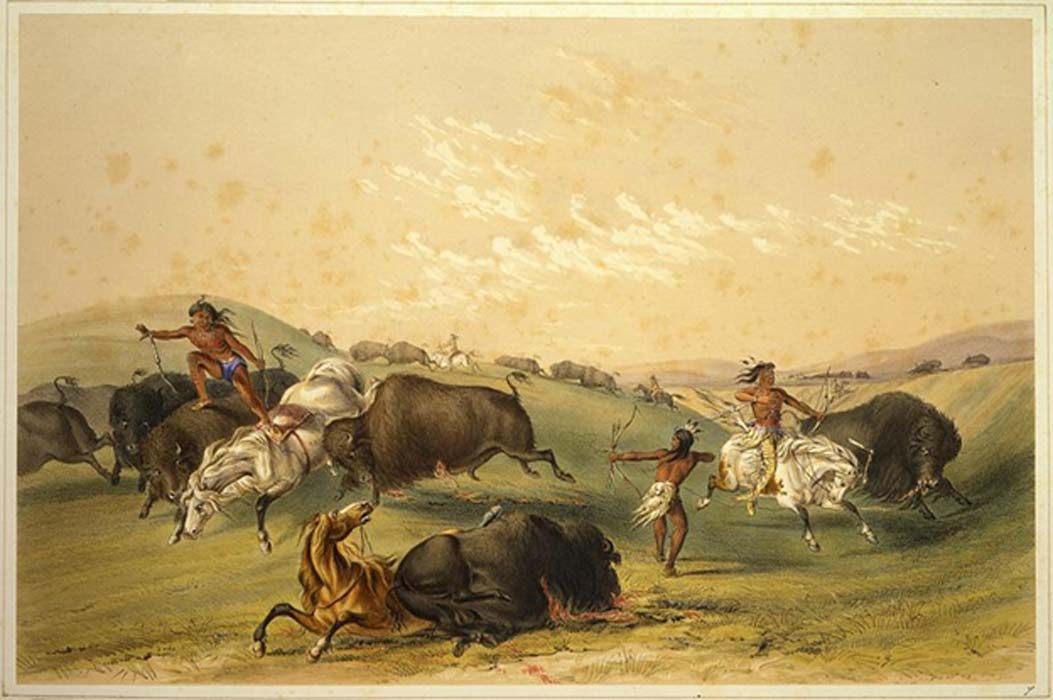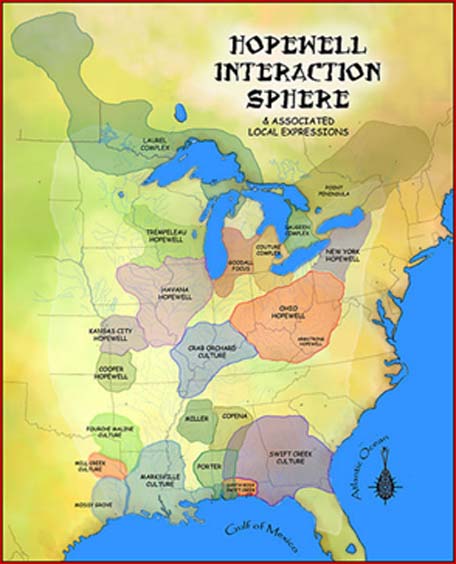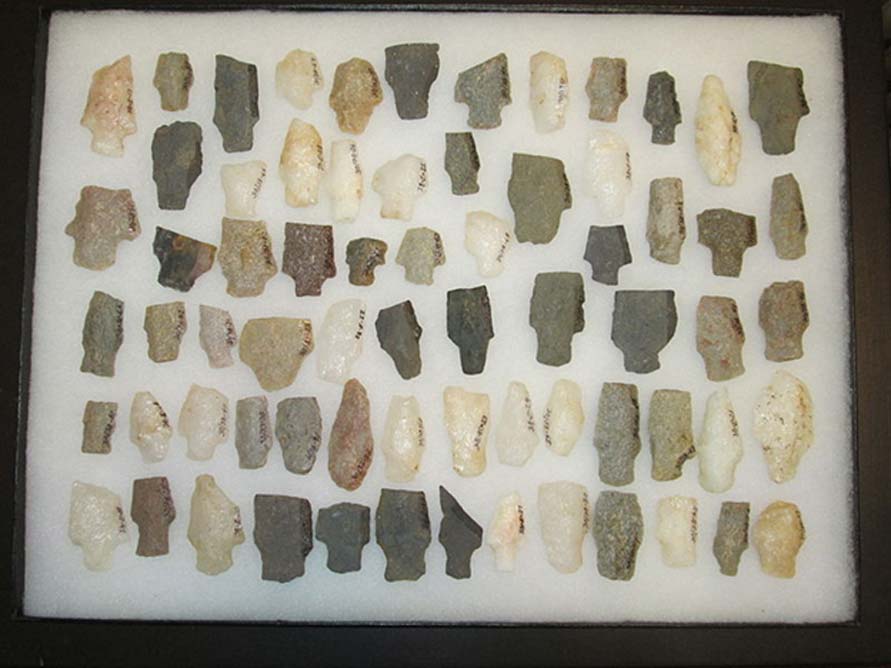
The Social Impact of the Bow and Arrow on Prehistoric America
A new technology in weaponry, the introduction of the bow and arrow, might have led to the collapse of the prehistoric, American Hopewellian Culture somewhere between 450 to 500 AD. A socio-spiritual tripartite existed between the Scotio Hopewell cultures and these three communities congregated at times to bury their dead in communal mounds. Such religious ceremonies reinforced the alliances between the living and their ancestors and strengthened their kinship ties. However, something upset this alliance, which had a dramatic effect upon the cultures. Archaeologists noticed a reduction in the sizes of projectile points, which identifies the arrival of the bow and arrow to the scene. This may not seem such a huge event, but it impacted on the interdependence and sharing of food resources during communal gatherings. The bow being much more accurate than the spear, facilitated autonomous hunting by smaller groups, and eliminated the need for large scale hunting drives. Thus, a tripartite alliance could have collapsed, as is evident from a decline in joined burials. The introduction of the bow and arrow, and consequently more autonomous living, triggered an exploitation of wild game, an increase in the cultivation of crops, and a trend towards sedentary and nucleated communities.

The Hopewell Interaction Sphere and various local expressions of the Hopewell cultures by H Rowe (CC BY-SA 3.0)
Timing of the Introduction of the Bow and Arrow
In archaeology, there are some tried and true ideas that stand the test of time, enduring careful scrutiny and the subsequent discovery of additional evidence. On the other side of the coin, there are ideas, which although enshrined and often repeated in a barrage of cognitive reinforcement, should have been cast to the winds long ago, in light of new discoveries and experiments. Since archaeological interpretation is a largely holistic endeavor incorporating multiple streams of knowledge and study, even one problematic concept, which has outlived its own credibility, can serve to blind researchers to the answers they seek or even derail entire fields of inquiry. One such problem in American archaeology is the timing of the introduction of the bow and arrow in the Eastern Woodlands.
The traditional and currently accepted timing for the introduction of the bow and arrow in the Ohio Valley is sometime between 600 and 800 AD, depending on the source. At the present writing, most sources attribute the technology’s arrival to a group of people sometimes known as the Intrusive Mound Culture, so named for the practice of burying their own dead in the older burial mounds of the Adena and Hopewell cultures. The Intrusive Mound Culture appears around 600 AD and persists throughout the Late Woodland Period. Their toolkits include Jack’s Reef points, which are often considered the earliest arrow points in the region. Archaeologists and linguists have debated the origins and identity of the Intrusive Mound Culture for decades. Some believe that they were a new people intruding into the Ohio Valley, while others feel that they represent a new culture evolving out of local traditions.
- Bones of the Child, Tools of the Shaman: Ritual and Cosmology at the Hopewell Tunacunnhee Mounds
- Mystery enshrouds ancient Native Americans who built burial mounds
- Human Blood Found on Ancient Maya Arrowheads, Bloodletting Rituals to Feed Life Force to the Gods
The Intrusive Mound Culture followed the Adena (1000 BC to 300 AD) and Hopewell (200 BC to 500 AD) mound building cultures. Ancestral to both Adena and Hopewell was a culture alternately known as Red Ocher or Glacial Kame, which dates back as far as 1500 BC. Wherever these cultures are found in the north-east, they are usually linked over time in this ancestor-descendant continuum, although they are usually known by different names in different regions. What is very interesting is that just across the border in Canada, archaeologists have conducted important studies, which offer a profound contradiction to the conventional timing of the introduction of the bow and arrow into this cultural continuum as embraced by most American archaeologists.

Prehistoric Native American projectile points. The smaller ones are arrowheads, and the larger ones are spearheads. (CC BY-SA 3.0)
In southern Ontario the Red Ocher—Glacial Kame Culture is associated with a series of projectile points sometimes referred to as the Small Point Complex. Small Point varieties include Innes, Crawford Knoll, and Hind points, which are related to contemporaneous Merom Expanding Stemmed and Trimble Side-notched in the United States. Some archaeologists believe that the smaller size of these point varieties indicate a shift from spear thrower to bow and arrow technology occurring by around 1400 BC. Glacial Kame sites in Ontario where Small Points have been found which function as arrow heads, include the Crawford Knoll (1400 BC), Innes (800 BC), and Parkhill (1500 BC) sites. While the arrow heads may have appeared during Late Archaic times, discriminate function studies suggest that for whatever the reason, they became less popular during the ensuing Early Woodland period (circa 1000 BC). The implications for these studies are obvious: if the Red Ocher—Glacial Kame Culture possessed the bow and arrow in southern Ontario, then why would groups participating in the same culture to the south with similar point assemblages, not use the same technology?
Indeed, independent research suggests that a major Red Ocher burial site in Michigan can also count arrowheads among its artifact inventory. Scientific studies by E.J. Neiburger suggests that 25 rolled copper points recovered from the Riverside site along the Menominee River in Menominee County are in fact arrowheads. Neiburger’s experiments with these copper points revealed that the skirts fit a typical arrow shaft. He suggests that the scarcity of Late Archaic arrowheads could be due to the technology having been the province of an exclusive or elite group. The Riverside site was in use as far back as around 1100 BC.




